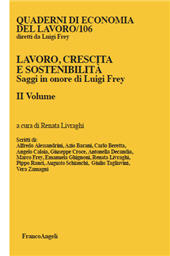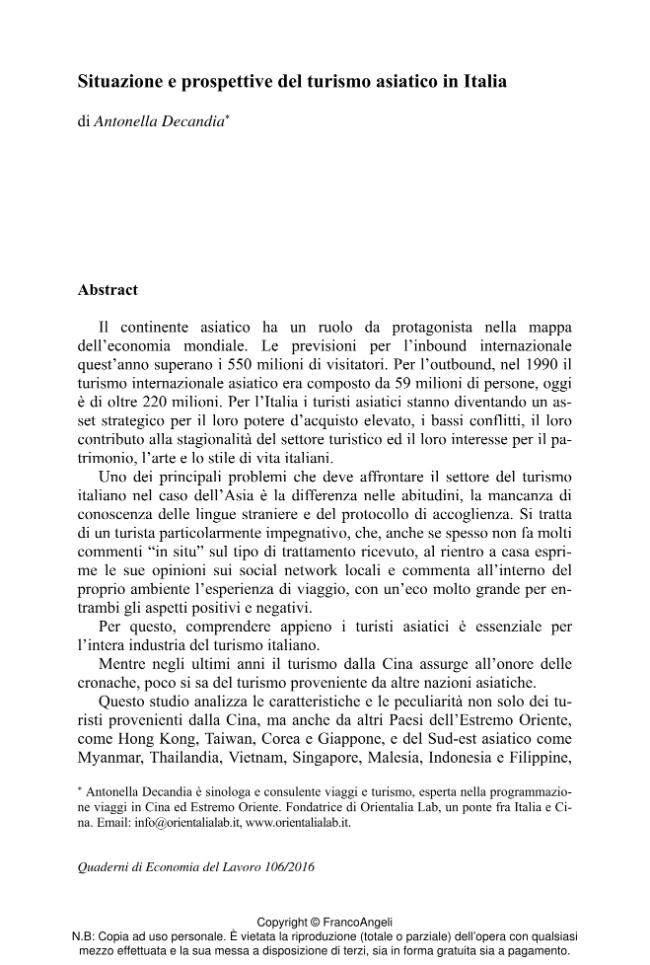Situazione e prospettive del turismo asiatico in Italia
181-222 p.
Il continente asiatico ha un ruolo da protagonista nella mappa dell'economia mondiale. Le previsioni per l'inbound internazionale quest'anno superano i 550 milioni di visitatori. Per l'outbound, nel 1990 il turismo internazionale asiatico era composto da 59 milioni di persone, oggi è di oltre 220 milioni. Per l'Italia i turisti asiatici stanno diventando un asset strategico per il loro potere d'acquisto elevato, i bassi conflitti, il loro contributo alla stagionalità del settore turistico ed il loro interesse per il patrimonio, l'arte e lo stile di vita italiani. Uno dei principali problemi che deve affrontare il settore del turismo italiano nel caso dell'Asia è la differenza nelle abitudini, la mancanza di conoscenza delle lingue straniere e del protocollo di accoglienza.
Si tratta di un turista particolarmente impegnativo, che, anche se spesso non fa molti commenti "in situ" sul tipo di trattamento ricevuto, al rientro a casa esprime le sue opinioni sui social network locali e commenta all'interno del proprio ambiente l'esperienza di viaggio, con un'eco molto grande per entrambi gli aspetti positivi e negativi. Per questo, comprendere appieno i turisti asiatici è essenziale per l'intera industria del turismo italiano.
Mentre negli ultimi anni il turismo dalla Cina assurge all'onore delle cronache, poco si sa del turismo proveniente da altre nazioni asiatiche. Questo studio analizza le caratteristiche e le peculiarità non solo dei turisti provenienti dalla Cina, ma anche da altri Paesi dell'Estremo Oriente, come Hong Kong, Taiwan, Corea e Giappone, e del Sud-est asiatico come Myanmar, Thailandia, Vietnam, Singapore, Malesia, Indonesia e Filippine, con consigli su come adeguare l'offerta turistica per ciascuno di questi ospiti con le loro similitudini e differenze. [Testo dell'editore].
The Asian continent has a starring role in the world economic map. Forecasts for international inbound year exceed the 550 million visitors. For outbound, in 1990 the Asian international tourism was made up of 59 million people, now has more than 220 million. For Italy Asian tourists are becoming a strategic asset for their high purchasing power, low conflict, their contribution to the seasonal nature of the tourism industry and their interest in heritage, art and Italian lifestyle. One of the main problems facing the sector of Italian tourism in the case of Asia is the difference in customs, the lack of knowledge of foreign languages and the hosting protocol. It is a particularly demanding tourist, who, though often does not make many comments "in situ" on the type of treatment received, returning home expresses his point of view on local social networks and comments his travel experience inside his environment, with a very great echo for both the positive and negative aspects.
For this, fully understand the Asian tourists is vital for the whole industry of Italian tourism. While in recent years, tourism from China rises in the news, little is known of tourism from other Asian nations. This study analyzes the characteristics and peculiarities of the tourists not only from China but also from other countries of the Far East, such as Hong Kong, Taiwan, Korea and Japan, and South-East Asia such as Myanmar, Thailand, Vietnam, Singapore, Malaysia, Indonesia and the Philippines, with advice on how to adapt the touristic offer for each of these guests with their similarities and differences. [Publisher's Text].
Forma parte de
Quaderni di economia del lavoro : 106, 2, 2016-
Artículos del mismo número (disponibles individualmente)
-
Información
Código DOI: 10.3280/QUA2016-106010
MATERIAS



